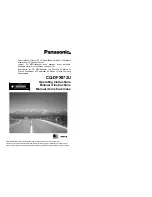
3-15
Copyright 2008 Cirrus Logic, Inc.
DS732UM7
SPI Port
CS4953xx Hardware Users Manual
3.3.1 SPI System Bus Description
The SPI bus is a multi-master bus. This means that more than one device capable of controlling the bus can be
connected to it. Generation of clock signals on the SPI bus is always the responsibility of master devices; each
master generates its own clock signals when transferring data on the bus. Bus clock signals from a master cannot be
altered by any other device on the bus, otherwise a collision will occur. The slave chip-select signals can only be
controlled by master devices.
The CS4953xx has two serial ports. However, the O/S currently supports only slave mode host communication on
SCP1, and master mode communication on SCP2 for booting from a serial EEPROM/FLASH.
SCP1_MOSI (Master Out/Slave In) and SCP1_MISO (Master In/Slave Out) are bidirectional lines that change their
behavior depending on whether the device is operating in master or slave mode. Only the master can drive the MOSI
signal while only the slave can drive the MISO signal.
Figure 3-13. Block Diagram of SPI System Bus
As seen in
, two serial ports are available on the CS4953xx. Each can be configured to either a master or
slave. For audio applications, SCP1 is configured as a slave port and SCP2 is configured as a master port. SCP2 is
used only in systems that are booting from serial EEPROM.
3.3.2 SPI Bus Dynamics
A SPI transaction begins by the master driving the slave chip select SCP1_CS low. SPI transactions end by the
master driving the SCP1_CS high. This SPI bus is considered busy while any device’s SCP1_CS signal is low. The
bus is free only when all slave SCP1_CS signals are high. A high-to-low transition on the SCP1_CS line defines an
SPI Start condition. A low-to-high transition on the SCP1_CS line defines an SPI Stop condition. Start and Stop
conditions are always generated by the master. The bus is considered to be busy after the Start condition. The bus is
considered to be free again following the Stop condition.
The data bits of the SCP1_MOSI and SCP1_MISO line are valid on the rising edge of SCP1_CLK. It is the slave’s
responsibility to accept or supply bytes on the bus at the rate at which the master is driving SCP1_CLK.
All data put on the SCP1_MOSI and SCP1_MISO lines must be in 8-bit bytes. The number of bytes that can be
transmitted per transfer is unrestricted. Data is transferred with the most-significant bit (MSB) first. For the
CS4953xx slave SPI port, the first byte is an address byte that is always sent by the master after a Start condition.
This address byte is an “I
2
C-type” command of a 7-bit a a R/W bit. The 7-bit SPI address is 1000000b
(0x80).
R E SE T
SC P 1_C S
SC P 1_C LK
SC P 1_M O SI
SC P 1_M ISO
SC P 1_IR Q
SC P 1_B S Y
S ystem
M icrocontroller
C S 4953xx
M O SI
M ISO
S P I E E P R O M
M O SI
M ISO
R E SE T
C S
C LK
SC P 2_C LK
SC P 2_M O SI
SC P 2_M ISO
EE _C S
3.3k
3.3k
3.3V
MA
S
T
E
R
ON
L
Y
S
L
AV
E
ONLY
Содержание CS4953xx
Страница 34: ...Softboot CS4953xx Hardware Users Manual DS732UM7 Copyright 2008 Cirrus Logic Inc 2 18 ...
Страница 56: ...SPI Port CS4953xx Hardware Users Manual DS732UM7 Copyright 2008 Cirrus Logic Inc 3 22 ...
Страница 58: ...CS4953xx Hardware Users Manual DS732UM7 Copyright 2008 Cirrus Logic Inc 4 2 ...
Страница 88: ...SDRAM Flash Controller Interface CS4953xx Hardware Users Manual DS732UM7 Copyright 2008 Cirrus Logic Inc 8 10 ...
Страница 118: ...Revision History CS4953xx Hardware Users Manual DS732UM7 Copyright 2008 Cirrus Logic Inc 9 30 ...















































